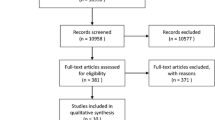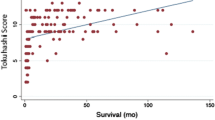Abstract
The aim of the study was to develop a new whole spinal MRI-based tumor burden scoring method in participants with newly diagnosed multiple myeloma (MM) and to explore its prognostic significance. We prospectively recruited participants with newly diagnosed MM; performed whole spinal MRI (sagittal FSE T1WI, sagittal IDEAL T2WI, and axial FLAIR T2WI) on them; and collected their clinical data, early treatment response, progression-free survival (PFS), and overall survival (OS). We developed a new tumor burden scoring method according to the extent of bone marrow infiltration in five MRI patterns. All participants were divided into good response and poor response groups after four treatment cycles. Univariate, multivariate analyses, and ROC were used to determine the performance of independent predictors. Thresholds for PFS and OS were calculated using X-tile, and their prognostic significance were assessed by Kaplan–Meier. The Kruskal–Wallis H test was used to compare the differences of tumor burden score between the revised International Staging System (R-ISS) stages. The new tumor burden scoring method was used in 62 participants (median score, 12; range, 0–18). The tumor burden score (OR 1.266, p = 0.002) was an independent predictor of poor response and the AUC was 0.838. Higher tumor burden scores were associated with shorter PFS (p = 0.002) and OS (p = 0.011). The tumor burden score was higher in R-ISS-III than in R-ISS-I and R-ISS-II (p = 0.016 and p = 0.006, respectively). The tumor burden score was an excellent predictor of prognosis and may serve as a supplemental marker for R-ISS.









Similar content being viewed by others
Data availability
The data that support the findings of this study are available on request from the corresponding author.
References
Ormond Filho AG, Carneiro BC, Pastore D et al (2019) Whole-body imaging of multiple myeloma: diagnostic criteria. Radiographics 39(4):1077–1097. https://doi.org/10.1148/rg.2019180096
Terpos E, Berenson J, Raje N, Roodman GD (2014) Management of bone disease in multiple myeloma. Expert Rev Hematol 7(1):113–125. https://doi.org/10.1586/17474086.2013.874943
Dall’Olio FG, Marabelle A, Caramella C et al (2022) Tumour burden and efficacy of immune-checkpoint inhibitors. Nat Rev Clin Oncol 19(2):75–90. https://doi.org/10.1038/s41571-021-00564-3
Giles SL, deSouza NM, Collins DJ et al (2015) Assessing myeloma bone disease with whole-body diffusion-weighted imaging: comparison with x-ray skeletal survey by region and relationship with laboratory estimates of disease burden. Clin Radiol 70(6):614–621. https://doi.org/10.1016/j.crad.2015.02.013
Shortt CP, Gleeson TG, Breen KA et al (2009) Whole-body MRI versus PET in assessment of multiple myeloma disease activity. AJR Am J Roentgenol 192(4):980–986. https://doi.org/10.2214/AJR.08.1633
Regelink JC, Minnema MC, Terpos E et al (2013) Comparison of modern and conventional imaging techniques in establishing multiple myeloma-related bone disease: a systematic review. Br J Haematol 162(1):50–61. https://doi.org/10.1111/bjh.12346
Cavo M, Terpos E, Nanni C et al (2017) Role of 18F-FDG PET/CT in the diagnosis and management of multiple myeloma and other plasma cell disorders: a consensus statement by the International Myeloma Working Group. Lancet Oncol 18(4):e206–e217. https://doi.org/10.1016/S1470-2045(17)30189-4
Hillengass J, Landgren O (2013) Challenges and opportunities of novel imaging techniques in monoclonal plasma cell disorders: imaging “early myeloma.” Leuk Lymphoma 54(7):1355–1363. https://doi.org/10.3109/10428194.2012.740559
Lecouvet FE, Boyadzhiev D, Collette L et al (2020) MRI versus 18F-FDG-PET/CT for detecting bone marrow involvement in multiple myeloma: diagnostic performance and clinical relevance. Eur Radiol 30(4):1927–1937. https://doi.org/10.1007/s00330-019-06469-1
Baur-Melnyk A, Buhmann S, Dürr HR, Reiser M (2005) Role of MRI for the diagnosis and prognosis of multiple myeloma. Eur J Radiol 55(1):56–63. https://doi.org/10.1016/j.ejrad.2005.01.017
Moulopoulos LA, Gika D, Anagnostopoulos A et al (2005) Prognostic significance of magnetic resonance imaging of bone marrow in previously untreated patients with multiple myeloma. Ann Oncol 16(11):1824–1828. https://doi.org/10.1093/annonc/mdi362
Dimopoulos MA, Hillengass J, Usmani S et al (2015) Role of magnetic resonance imaging in the management of patients with multiple myeloma: a consensus statement. J Clin Oncol 33(6):657–664. https://doi.org/10.1200/JCO.2014.57.9961
Dutoit JC, Verstraete KL (2016) MRI in multiple myeloma: a pictorial review of diagnostic and post-treatment findings. Insights Imaging 7(4):553–569. https://doi.org/10.1007/s13244-016-0492-7
Mai EK, Hielscher T, Kloth JK et al (2015) A magnetic resonance imaging-based prognostic scoring system to predict outcome in transplant-eligible patients with multiple myeloma. Haematologica 100(6):818–825. https://doi.org/10.3324/haematol.2015.124115
Dong H, Huang W, Ji X et al (2022) Prediction of early treatment response in multiple myeloma using MY-RADS total burden score, ADC, and fat fraction from whole-body MRI: impact of anemia on predictive performance. AJR Am J Roentgenol 218(2):310–319. https://doi.org/10.2214/AJR.21.26534
Lai AYT, Riddell A, Barwick T et al (2020) Interobserver agreement of whole-body magnetic resonance imaging is superior to whole-body computed tomography for assessing disease burden in patients with multiple myeloma. Eur Radiol 30(1):320–327. https://doi.org/10.1007/s00330-019-06281-x
Silbermann R, Roodman GD (2013) Myeloma bone disease: pathophysiology and management. J Bone Oncol 2(2):59–69. https://doi.org/10.1016/j.jbo.2013.04.001
Rajkumar SV, Dimopoulos MA, Palumbo A et al (2014) International Myeloma Working Group updated criteria for the diagnosis of multiple myeloma. Lancet Oncol 15(12):e538–e548. https://doi.org/10.1016/S1470-2045(14)70442-5
Kumar S, Paiva B, Anderson KC et al (2016) International Myeloma Working Group consensus criteria for response and minimal residual disease assessment in multiple myeloma. Lancet Oncol 17(8):e328–e346. https://doi.org/10.1016/S1470-2045(16)30206-6
Messiou C, Hillengass J, Delorme S et al (2019) Guidelines for acquisition, interpretation, and reporting of whole-body MRI in myeloma: myeloma response assessment and diagnosis system (MY-RADS). Radiology 291(1):5–13. https://doi.org/10.1148/radiol.2019181949
Moulopoulos LA, Dimopoulos MA, Christoulas D et al (2010) Diffuse MRI marrow pattern correlates with increased angiogenesis, advanced disease features and poor prognosis in newly diagnosed myeloma treated with novel agents. Leukemia 24(6):1206–1212. https://doi.org/10.1038/leu.2010.70
Moulopoulos LA, Dimopoulos MA, Kastritis E et al (2012) Diffuse pattern of bone marrow involvement on magnetic resonance imaging is associated with high risk cytogenetics and poor outcome in newly diagnosed, symptomatic patients with multiple myeloma: a single center experience on 228 patients. Am J Hematol 87(9):861–864. https://doi.org/10.1002/ajh.23258
Greipp PR, San Miguel J, Durie BG et al (2005) International staging system for multiple myeloma. J Clin Oncol 23(15):3412–3420. https://doi.org/10.1200/JCO.2005.04.242
Palumbo A, Avet-Loiseau H, Oliva S et al (2015) Revised International staging system for multiple myeloma: a report from International Myeloma Working Group. J Clin Oncol 33(26):2863–2869. https://doi.org/10.1200/JCO.2015.61.2267
Kastritis E, Terpos E, Roussou M et al (2017) Evaluation of the Revised International Staging System in an independent cohort of unselected patients with multiple myeloma. Haematologica 102(3):593–599. https://doi.org/10.3324/haematol.2016.145078
Jimenez-Zepeda VH, Duggan P, Neri P, Rashid-Kolvear F, Tay J, Bahlis NJ (2016) Revised international staging system applied to real world multiple myeloma patients. Clin Lymphoma Myeloma Leuk 16(9):511–518. https://doi.org/10.1016/j.clml.2016.06.001
Radocha J, Maisnar V, Pour L et al (2018) Validation of multiple myeloma risk stratification indices in routine clinical practice: analysis of data from the Czech Myeloma Group Registry of Monoclonal Gammopathies. Cancer Med 7(8):4132–4145. https://doi.org/10.1002/cam4.1620
González-Calle V, Slack A, Keane N et al (2018) Evaluation of Revised International Staging System (R-ISS) for transplant-eligible multiple myeloma patients. Ann Hematol 97(8):1453–1462. https://doi.org/10.1007/s00277-019-03702-1
Ozaki S, Handa H, Saitoh T et al (2019) Evaluation of the Revised International Staging System (R-ISS) in Japanese patients with multiple myeloma. Ann Hematol 98(7):1703–1711. https://doi.org/10.1007/s00277-019-03702-1
Han Y, Sunwoo L, Ye JC (2020) k-space deep learning for accelerated MRI. IEEE Trans Med Imaging 39(2):377–386. https://doi.org/10.1109/TMI.2019.2927101
Hyun CM, Kim HP, Lee SM, Lee S, Seo JK (2018) Deep learning for under sampled MRI reconstruction. Phys Med Biol 63:aac71a. https://doi.org/10.1088/1361-6560/aac71a
Funding
This study has received funding by National Natural Science Foundation of China (NSFC 82071898).
Author information
Authors and Affiliations
Contributions
Conception and design of study: Sha Cui, Yinnan Guo, and Jinliang Niu; collection and assembly of data: Sha Cui, Jianting Li, Wenjin Bian, and Wenqi Wu; follow-up of participants: Sha Cui and Yinnan Guo; statistical analysis: Sha Cui and Wenjia Zhang; analysis and interpretation of data: Sha Cui, Qian Zheng, and Haonan Guan; manuscript writing: Sha Cui and Yinnan Guo; critical review: Jinliang Niu and Jun Wang.
Corresponding author
Ethics declarations
Ethics approval
This study received approval from the ethics committee of the Second Hospital of Shanxi Medical University (protocol number 2020–040).
Consent to participate
Informed consent was obtained from all individual participants included in the study.
Conflict of interest
The authors declare no competing interests.
Additional information
Publisher's Note
Springer Nature remains neutral with regard to jurisdictional claims in published maps and institutional affiliations.
Rights and permissions
Springer Nature or its licensor (e.g. a society or other partner) holds exclusive rights to this article under a publishing agreement with the author(s) or other rightsholder(s); author self-archiving of the accepted manuscript version of this article is solely governed by the terms of such publishing agreement and applicable law.
About this article
Cite this article
Cui, S., Guo, Y., Li, J. et al. Development of a whole spinal MRI-based tumor burden scoring method in participants with multiple myeloma: a pilot study of prognostic significance. Ann Hematol 103, 1665–1673 (2024). https://doi.org/10.1007/s00277-024-05642-x
Received:
Accepted:
Published:
Issue Date:
DOI: https://doi.org/10.1007/s00277-024-05642-x




